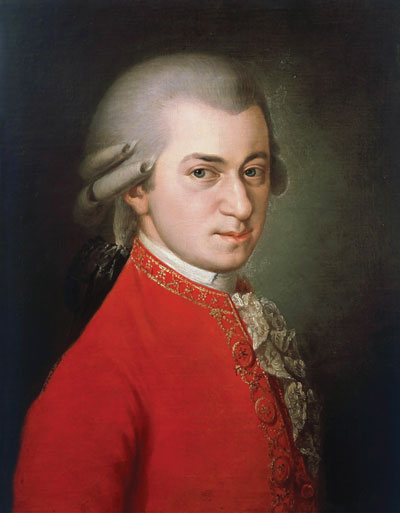Wolfgang Amadeus Mozart

- Born: January 27, 1756, Salzburg, Austria
- Died: December 5, 1791, Vienna, Austria
Serenade in G Major, K. 525, Eine kleine Nachtmusik
- Composed: 1787
- Instrumentation: strings
- CSO notable performances: First: April 1916, Ernst Kunwald conducting. Most Recent: May 2000, Jesús López Cobos conducting. Other: June 1992, Riverbend Pops conducted by Bobby McFerrin.
- Duration: approx. 16 minutes
Eine kleine Nachtmusik is at once one of the most familiar yet one of the most mysterious of Mozart’s works. He dated the completed manuscript August 10, 1787, the day he entered it into his catalog of compositions as “Eine kleine Nachtmusik, bestehend in einem [consisting of an] Allegro, Menuett und Trio—Romance, Menuett und Trio, Finale. 2 Violini, Viola e Bassi.” There is no other contemporary record of the work’s provenance, composition or performance. It was the first work of the serenade type he had written since the magnificent C Minor Wind Octet (K. 388) of 1782, and it seems unlikely that, at a time when he was increasingly mired in debt, he would have returned to the genre without some promise of payment. Indeed, he had to set aside his furious preparations for the October premiere of Don Giovanni in Prague to compose the piece. (The eventful year 1787 also saw Mozart’s meeting with Beethoven—“He will soon make a noise in the world,” Mozart prophesied—as well as the aborted plans to move to England with his friends the Storaces and Michael Kelly, and the death of his father.) The simple, transparent style of Eine kleine Nachtmusik, reminiscent of the music of Mozart’s Salzburg years and so different from the rich expression of his later music, except for the dances he wrote for the Habsburg court balls, suggests that it was designed for amateur performance, perhaps at the request of some aristocratic Viennese player of limited musical ability. The word “bassi” in the catalog entry implies that it was conceived for a quintet of strings (in its 18th-century context, “bassi” meant cellos doubled by basses) or for a small string orchestra, but there is not a scrap of further evidence concerning the piece, and Mozart’s exact intentions as to its performing forces will probably remain forever unknown.
As to the formal type of Eine kleine Nachtmusik, John N. Burk said it is “unclassifiable.” Burk noted that it was included among the string quartets in Ludwig Köchel’s catalog and in the Breitkopf und Härtel edition of Mozart’s works, “but it has nothing in common with Mozart’s intricate quartet writing at that time.” The titular word “Nachtmusik”—“night music” or Notturno—would seem to place it among the various genres of 18th-century entertainment music, as would the five movements specified by Mozart’s catalog entry. The fifth movement, a minuet and trio originally placed between the opening Allegro and the Romanza, has completely disappeared. The autograph manuscript consists of eight leaves clearly numbered one to eight, but the third page has been torn from the small volume—by Mozart? by a souvenir hunter? by an editor? (the piece was unpublished until 1827). Alfred Einstein guessed that the minuet was transferred to the partly spurious Clavier Sonata, K. Anhang (=appendix, in German) 136, but offers no evidence.
Eine kleine Nachtmusik is an enigma, a wonderful, isolated chronological and stylistic aberration of Mozart’s mature years that raises to perfection the simple musical gestures of his boyhood. Was it a piece, like the courtly dances, that he tossed off so quickly he did not have time to invest it with any complexities? Did his patron (Mozart never composed any other of his serenades without a definite commission) require something without the incipient Romanticisms that were the composer’s growing obsession? Was it some kind of nostalgic tonal reminiscence of the bright days of his youth—a kind of memorial to his father, dead only three months? Unanswerable questions, these, yet not without some bearing on the perception of this familiar music. Though sunny and cheerful throughout, when seen in the light of its immediate musical companions of 1787—Don Giovanni, the A Major Violin Sonata (K. 526) and the C Major and G Minor String Quintets (K. 515 and 516)—Eine kleine Nachtmusik takes on an added depth of expression as much for what it eschews as for what it contains.
—Dr. Richard E. Rodda